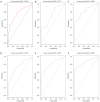Prediction of overall survival of non-small cell lung cancer with bone metastasis: an analysis of the Surveillance, Epidemiology and End Results (SEER) database
- PMID: 35116369
- PMCID: PMC8797363
- DOI: 10.21037/tcr-21-1507
Prediction of overall survival of non-small cell lung cancer with bone metastasis: an analysis of the Surveillance, Epidemiology and End Results (SEER) database
Abstract
Background: The prognosis of non-small cell lung cancer (NSCLC) patients with bone metastasis is extremely repulsive. The aim of this study was to potentially characterize the prevalence, associated factors and to establish a prognostic nomogram to predict the overall survival (OS) of NSCLC patients with bone metastasis.
Methods: The Surveillance, Epidemiology and End Results (SEER) database was used to collected NSCLC cases during 2010-2015. The cases with incomplete clinicopathological information were excluded. Finally, 484 NSCLC patients with bone metastasis were included in the present study and randomly divided into the training (n=340) and validation (n=144) cohorts in a ratio of 7:3 based on R software. NSCLC patients with bone metastasis were selected to investigate predictive factors for OS and cancer-specific survival (CSS) using the multivariable Cox proportional hazards regression. A nomogram incorporating these prognostic factors was developed and evaluated by a concordance index (C-index), calibration plots, and risk group stratifications.
Results: In the Cox proportional hazards model, sex, race, American Joint Committee on Cancer (AJCC) N, T stage, liver metastasis, and chemotherapy were regarded as prognostic factors of OS. The nomogram based on sex, race, AJCC N, T stage, liver metastasis and chemotherapy was developed for cancer-specific death to predict 1-, 3-, and 5-year survival rate with good performance. The C-index of established nomogram was 0.695 for cancer-specific death in the study population with an acceptable calibration.
Conclusions: The female gender, the patients with chemotherapy and not liver metastasis may indicate improved survival. However, the global prospective data with the latest tumor, node, metastasis (TNM) classification is needed to further improve this model.
Keywords: Nomogram; Surveillance, Epidemiology and End Results (SEER) bone metastasis; non-small cell lung cancer (NSCLC); overall survival (OS).
2021 Translational Cancer Research. All rights reserved.
Conflict of interest statement
Conflicts of Interest: All authors have completed the ICMJE uniform disclosure form (available at https://dx.doi.org/10.21037/tcr-21-1507). JX was funded by the Natural Science Foundation of Heilongjiang Province (No. H2018019). The other authors have no conflicts of interest to declare.
Figures





Similar articles
-
Development and validation of a nomogram for predicting the overall survival in non-small cell lung cancer patients with liver metastasis.Transl Cancer Res. 2023 Nov 30;12(11):3061-3073. doi: 10.21037/tcr-23-899. Epub 2023 Oct 26. Transl Cancer Res. 2023. PMID: 38130305 Free PMC article.
-
Construction of a nomogram predicting the overall survival of patients with distantly metastatic non-small-cell lung cancer.Cancer Manag Res. 2018 Nov 22;10:6143-6156. doi: 10.2147/CMAR.S183878. eCollection 2018. Cancer Manag Res. 2018. PMID: 30538562 Free PMC article.
-
Development and validation of a Surveillance, Epidemiology, and End Results (SEER)-based prognostic nomogram for predicting survival in elderly patients with gastric cancer after surgery.J Gastrointest Oncol. 2021 Apr;12(2):278-296. doi: 10.21037/jgo-20-536. J Gastrointest Oncol. 2021. PMID: 34012626 Free PMC article.
-
Development and validation of prognostic models for small cell lung cancer patients with liver metastasis: a SEER population-based study.BMC Pulm Med. 2024 Jan 4;24(1):13. doi: 10.1186/s12890-023-02832-7. BMC Pulm Med. 2024. PMID: 38178079 Free PMC article.
-
Prognostic factors and nomogram for cancer-specific death in non small cell lung cancer with malignant pericardial effusion.PLoS One. 2019 May 16;14(5):e0217007. doi: 10.1371/journal.pone.0217007. eCollection 2019. PLoS One. 2019. PMID: 31095610 Free PMC article.
Cited by
-
A Challenging Case of Metastatic Non-Small Cell Carcinoma of the Lung.Cureus. 2023 Apr 30;15(4):e38319. doi: 10.7759/cureus.38319. eCollection 2023 Apr. Cureus. 2023. PMID: 37261190 Free PMC article.
-
Development and validation of a nomogram for predicting the overall survival in non-small cell lung cancer patients with liver metastasis.Transl Cancer Res. 2023 Nov 30;12(11):3061-3073. doi: 10.21037/tcr-23-899. Epub 2023 Oct 26. Transl Cancer Res. 2023. PMID: 38130305 Free PMC article.
-
Development and validation of a prognostic nomogram for bone metastasis from lung cancer: A large population-based study.Front Oncol. 2022 Sep 30;12:1005668. doi: 10.3389/fonc.2022.1005668. eCollection 2022. Front Oncol. 2022. PMID: 36249042 Free PMC article.
-
Bone Metastasis and Immune Checkpoint Inhibitors in Non-Small Cell Lung Cancer (NSCLC): Microenvironment and Possible Clinical Implications.Int J Mol Sci. 2022 Jun 20;23(12):6832. doi: 10.3390/ijms23126832. Int J Mol Sci. 2022. PMID: 35743275 Free PMC article. Review.
-
Metastatic pattern and prognosis in patients with lung adenosquamous carcinoma: A surveillance, epidemiology, and end results-based population study.Heliyon. 2024 May 6;10(9):e30641. doi: 10.1016/j.heliyon.2024.e30641. eCollection 2024 May 15. Heliyon. 2024. PMID: 38765098 Free PMC article.
References
-
- Howlader N, Noone AM, Krapcho M, et al. SEER Cancer Statistics Review, 1975-2011. National Cancer Institute 2014. Available online: https://seer.cancer.gov/archive/csr/1975_2011/
LinkOut - more resources
Full Text Sources
